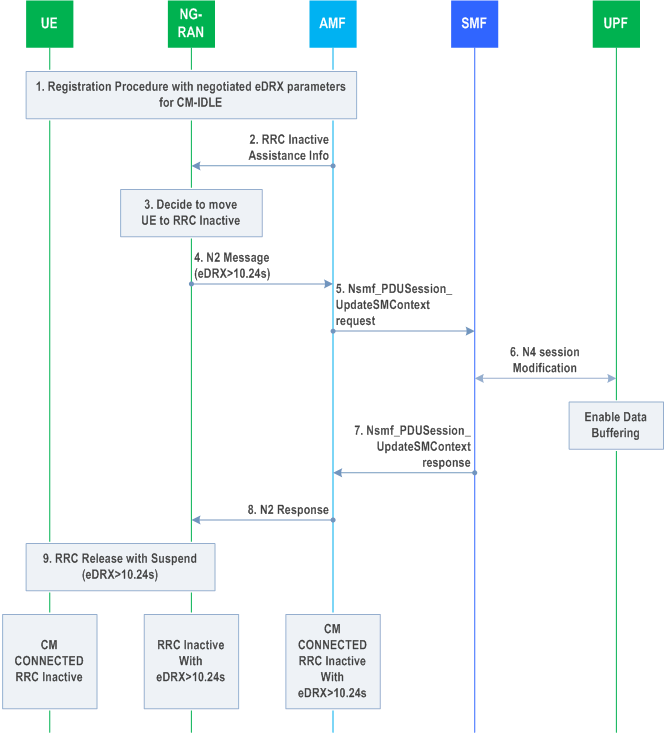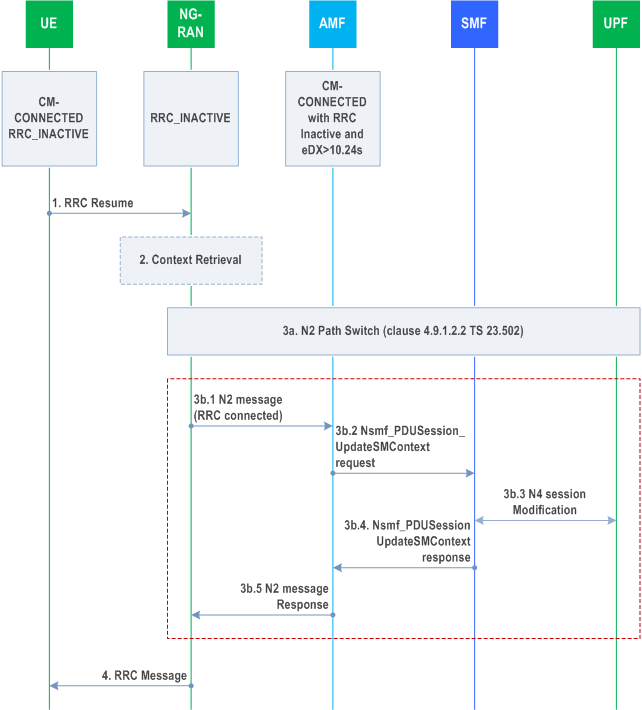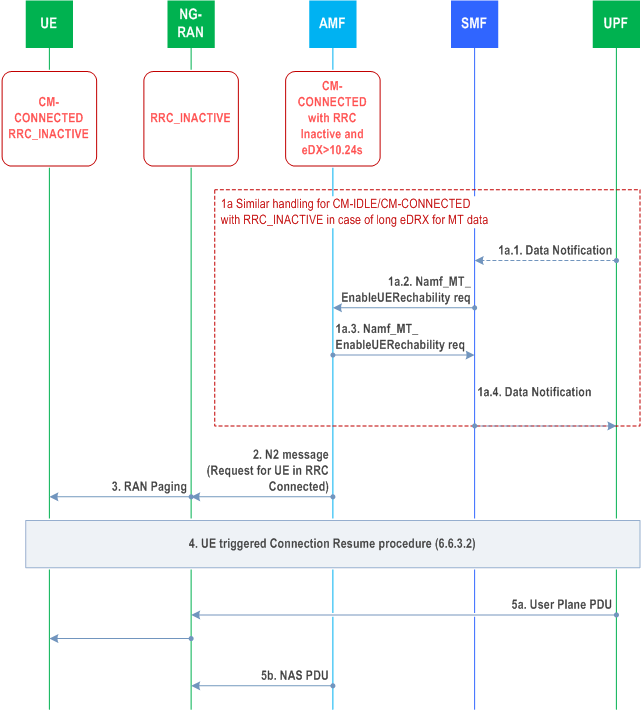Content for TR 23.700-68 Word version: 18.1.0
6.6 Solution #6: Converged Solution for handling RRC inactive with eDRX > 10.24s.
6.6.1 Introduction
6.6.2 Functional Description
6.6.3 Procedures
6.6.3.1 UE entering CM-CONNECTED with RRC Inactive and eDRX > 10.24s
6.6.3.2 UE triggered Connection Resume procedure
6.6.3.3 Network triggered Connection Resume procedure
6.6.4 Impacts on services, entities and interfaces
...
...
6.6 Solution #6: Converged Solution for handling RRC inactive with eDRX > 10.24s. p. 26
6.6.1 Introduction p. 26
The solution applies to Key Issue #1 and covers both sub-aspects of the key issue. The solution is meant to converge Solutions #1 (clause 6.1), #3 (clause 6.3), and #4 (clause 6.4).
6.6.2 Functional Description p. 27
If the AMF has indicated support of eDRX > 10.24s for CM-CONNECTED with RRC Inactive, and has provided idle mode eDRX cycle length, the NG-RAN (i.e. gNB) may at any point configure the UE with eDRX > 10.24s when moving the UE to CM-CONNECTED with RRC Inactive.
When the UE is moved to RRC-Inactive with eDRX > 10.24s, the NG-RAN notifies the AMF via N2 signalling. The AMF enters a substate of CM-CONNECTED, denoted "CM-CONNECTED with RRC Inactive and eDRX > 10.24s". In this state, the AMF follows similar behaviour as for CM-IDLE when the UE is unreachable when interacting with other NFs.
When the UE is CM-CONNECTED with RRC Inactive state and eDRX > 10.24s, DL data is buffered in CN and NAS procedures are not executed, except paging procedure when UE is considered reachable by AMF, until the UE returns to RRC-Connected state.
When the UE moves back to RRC-Connected, the NG-RAN notifies the AMF via N2 signalling.
UE performs both AS and NAS level mobility and periodic AS update based on existing Rel-17 functions.
6.6.3 Procedures p. 27
6.6.3.1 UE entering CM-CONNECTED with RRC Inactive and eDRX > 10.24s p. 27

Step 1.
The UE initiates the Registration Procedure and the eDRX parameters in CM-IDLE state are negotiated.
Step 2.
The AMF sends the Inactive Assistance Information to the NG-RAN. The eDRX parameters in CM-IDLE state are included as defined in clause 5.3.3.2.5 of TS 23.501. The AMF also includes support of CM CONNECTED with RRC Inactive and eDRX > 10.24s.
Step 3.
Before transitioning the UE into RRC_Inactive state, NG-RAN determines the eDRX parameters for UE in RRC_Inactive state.
Step 4.
When the NG-RAN decides to transition the UE to RRC Inactive state with eDRX > 10.24s, the NG-RAN sends N2 message to AMF indicating the UE is transitioning to RRC Inactive with eDRX > 10.24s.
Step 5.
For each of the PDU sessions for which user plane resources have been activated, the AMF invokes Nsmf_PDUSession_UpdateSMContext Request (PDU Session ID, Cause, Operation type, User Location Information, Age of Location Information, N2 SM Information (Secondary RAT usage data)) towards SMF. The Operation Type is set to a value that indicates to stop user plane DL data transmissions towards the UE and enable data buffering. The SMF starts data buffering for MT data if the data buffering is handled in SMF.
Step 6.
If data buffering is handled in UPF, the SMF updates the UPF with proper rules for MT data handling.
Step 7.
The SMF sends the Nsmf_PDUSession_UpdateSMContext response.
Step 8.
The AMF sends N2 response to NG-RAN confirming CM-CONNECTED with RRC Inactive and eDRX > 10.24s state. The AMF enters CM-CONNECTED with RRC Inactive and eDRX > 10.24s state.
Step 9.
NG-RAN initiates RRC Release with Suspend procedure configuring eDRX > 10.24s. The UE enters CM connected with RRC Inactive and UE performs both AS and NAS level mobility and periodic AS update based on existing Rel-17 functions.
6.6.3.2 UE triggered Connection Resume procedure p. 28
Figure 6.6.3.2-1 shows the call flow for UE triggered Connection Resume procedure when the UE is in CM-CONNECTED with RRC Inactive and eDRX > 10.24s.

Step 1.
UE to NG-RAN: RRC message (Resume ID).
The UE initiates the transition from RRC Inactive state to RRC Connected state, see TS 38.300. The UE provides its Resume ID needed by the NG-RAN to access the UE's stored Context.
Step 2.
[Conditional] NG-RAN performs UE Context Retrieval.
UE Context Retrieval is performed when the UE Context associated with the UE attempting to resume its connection is not locally available at the accessed NG-RAN. The UE Context Retrieval procedure via NG-RAN is specified in TS 38.300.
Step 3a.
[Conditional] N2 Path switch procedure.
If the accessed NG-RAN is not the same as the NG-RAN that configured RRC Inactive, the accessed NG-RAN node initiates N2 Path Switch procedure, i.e. steps 1 to 8 of clause 4.9.1.2.2 in TS 23.502 and including Xn data forwarding.
Step 3b.
[Conditional] RRC Connected indication
Step 3b.1.
If the NG-RAN is the same as the NG-RAN that configured RRC Inactive (and still has UE context locally), the NG-RAN send N2 message to AMF indicating the UE is in CM-CONNECTED.
Step 3b.2.
The AMF invokes Nsmf_PDUSession_UpdateSMContext Request indicating the UE has resumed RRC connection for each SMF that applies.
Step 3b.3.
N4 session modification procedure is triggered by SMF. If data buffering is handled in UPF, the SMF updates the UPF with appropriate rules to no longer buffer data.
Step 3b.4.
The SMF sends the Nsmf_PDUSession_UpdateSMContext response.
Step 3b.5.
The AMF sends N2 response to NG-RAN confirming CM-CONNECTED.
Step 4.
NG-RAN sends RRC message to UE confirming to the UE that the UE has entered RRC Connected state.
6.6.3.3 Network triggered Connection Resume procedure p. 29
When the UE is in CM-CONNECTED with RRC Inactive and eDRX > 10.24s, all mobile terminated data handling, high latency communication, between AMF, SMF, UPF, SMSF and any other NF follow same signalling flow as for CM-IDLE.
Network triggered Connection Resume procedure may be triggered by MT data, or a network initiated NAS procedure from SMF and UPF as shown in Figure 6.6.3.3-1. When the procedure is triggered by other NFs (e.g., SMSF, LMF, GMLC), the UPF (or SMF) in the following figure should be replaced by the respective NF (the corresponding service operations used by other NFs when they communicate with AMF may also be different from the service operations used by SMF/UPF).
During the procedure, the NG-RAN (i.e. gNB) sends a RAN Paging to the UE based on N2 message from AMF in order to trigger the UE triggered Connection Resume procedure in clause 6.6.3.2.

Step 1.
There is a trigger in the AMF to Resume the RRC Connection for a UE.
Step 1a.
When downlink data is received and the SMF/UPF is requested to perform buffering as specified in clause 6.6.3.1 above, UPF/SMF checks with AMF for the possibility of data delivery, similar to step 2 of clause 4.24.2 of TS 23.502 with the following differences:
Step 1b.
- If AMF is in CM-CONNECTED with RRC Inactive and eDRX > 10.24s, and determines that UE is not reachable in RRC INACTIVE state based on the information provided from NG-RAN in clause 6.6.3.1, the AMF provides the Estimated Maximum Wait time in the response message based on the stored extended DRX information for RRC INACTIVE in AMF (see clause 6.6.3.1). This handling is similar to CM-IDLE with eDRX. When the AMF provides the Estimated Maximum Wait time, it can consider the time needed for RRC level procedures (e.g. RRC RNA update procedure) when UE wakes up from the eDRX cycle.
A need for network initiated NAS procedure or N2 procedure, including the case of MT data delivery, may be triggered in the AMF if the AMF consider UE is reachable when the UE state is CM-CONNECTED with RRC Inactive and eDRX > 10.24s.
Step 2.
The AMF sends N2 message to NG-RAN with request for the UE to be transitioned to RRC connected. The N2 message is triggered by either pending DL data buffered in the CN or pending MT NAS message as specified in step 1b.
Step 3.
The NG-RAN performs RAN paging.
Step 4.
When the UE receives RAN paging, it initiates Connection Resume, which triggers UE triggered Connection Resume procedure (see clause 6.6.3.2).
Step 5a.
User Plane PDUs are sent from UPF.
Step 5b.
AMF starts Network initiated NAS procedure, transmits DL NAS PDU and starts the corresponding NAS retransmission timer, or starts N2 procedure.
6.6.4 Impacts on services, entities and interfaces p. 31
AMF:
- eDRX parameters for RRC_INACTIVE state exchange on NGAP interface.
- Estimated Maximum Wait time calculation based on eDRX parameters from RRC_INACTIVE state.
- Notification of MT service on NGAP interface.
- New CM-CONNECTED substate, and potentially new N2 message.
- eDRX parameters for RRC_INACTIVE state exchange on NGAP interface.
- Notification of MT service on NGAP interface which triggers the RAN Paging.
- Potentially new N2 message.
- Supports data buffering/delivery Indication from AMF even in case of the N3 tunnel existence.
- none.